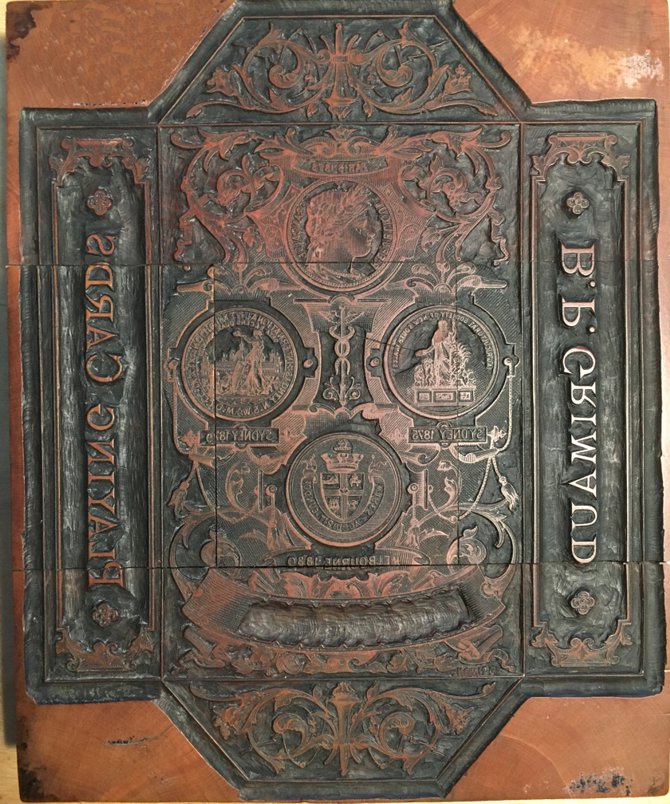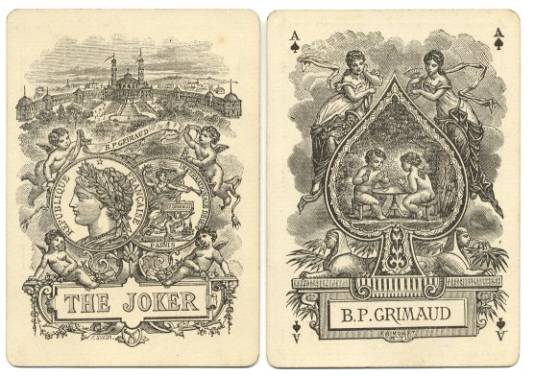 |
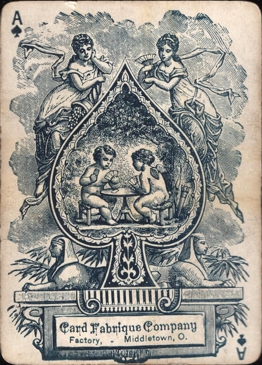 |
|
|
Figure 1 |
Figure 3a |
Figure 3b |
B.P.
GRIMAUD vs. CARD FABRIQUE COMPANY.
In the new Hochman Encyclopedia of Playing Cards the
Boudoirs deck by the Card Fabrique Company (L17, page 27) is dated “ca.
1880”.
On the following page there is a reference to a quite similar designed
Grimaud deck (L18a), that is dated as “ca. 1890”.
Although the text refers to possible links between the 2
manufacturers, by dating these decks in this way, it is suggested that the
Grimaud deck would be a take-off from the deck by the Card Fabrique Company. However, there are indications that this would be the other
way around. To illustrate this I have made detailed scans of the 2 significant
cards in the Grimaud deck.
 |
 |
|
|
Figure 1 |
Figure 3a |
Figure 3b |
To start with the Ace of Spades in figure 1: the
detailed scan in figure 2 of the spot between the Grimaud name and the small
ornament at the bottom, shows “F.SIMON Ft”. The “Ft” is an abbreviation
of the Latin word “fecit”, which means “he has made” and is a
historically known method in art of claiming ownership of the design.
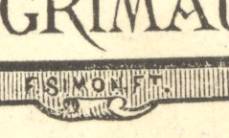
|
| Figure 2 |
On the Card Fabrique’s Ace in figures 3a (deck Scott Kruse) and 3b (deck Matt Schacht) his name has been made unreadable and the ornament unrecognizable. But they also show an other difference: in 3a the index is above the suit sign and in 3b it's the opposite. So there must have been at least 2 editions, of which the ace in figure 3a probably came with the first. Although I haven’t been able to find a direct link, it is a remarkable coincidence that the last name of the designer, F. Simon, is the same as the J.M. Simon from Nancy (France), who is -until today- the printer of decks, published by Grimaud.
Then there’s the joker in figure 1. The style of the
design bears great resemblance to that of the Ace of Spades. But that is not
surprising, as both were (de)signed by the same person, F. Simon. Figure 4 shows
his name at the bottom of the joker.
|
|
|
|
||
| Figure 4 | Figure 5 | Figure 6 |
The cupids, who hold the banner with B.P. Grimaud on the it, also return on the Ace of Spades to play a game of cards. The name of Grimaud is mentioned twice on the Joker: it is on the banner (figure 5) and also on one of the medals (figure 6).
The whole design of the Joker refers to the World Exhibition of 1878 in Paris. The building in the background is probably characteristic for this exhibition (compare to building on joker of the P22 Royal Playing Cards deck). From the text about P22 we can learn how easy it is to misjudge the date of a deck.
The L18a Grimaud deck was probably dated in the Hochman
Encyclopedia as ”ca. 1890”,
because of the tax stamp. We have a similar deck in our collection, with an 1890
stamp and an ornamented back-design (figure 7). The date on the tax stamp refers to the date that the law,
by which tax had to be paid, was implemented. No tax stamps were used before
1890. From 1813 on tax indications were only to be found in the emblem of the
Jack of Clubs in the French standard pattern. The last used indication is that
of 1853. The 1890 tax stamp was in use until 1917. The tax stamp was put on the
Ace of Clubs, when the decks became available to the general market.
It is not unusual that printers or publishers have a stock
of (first layer) prints left after the first publication and sell that stock
over the years. The Anglo-American pattern is not much used in France. As 99% of
the produced decks had the standard French (or Parisian) pattern in those days,
it’s not inconceivable that it has taken many years to sell the stock.
|
|
|
|
|
Figure 7 |
Figure 8 |
Only recently we found a second L18a Grimaud deck, no tax stamp and with a plain pink back (figure 8). These backs in plain pink or blue are usually older than the ornamented ones and were frequently used from ca. 1850 until ca. 1890. I don’t know how strong the dating is of the Card Fabrique L17 deck, but if that deck is correctly dated ca. 1880, then the Grimaud deck must have been published for the first time at the World Exhibition in Paris in 1878. Maybe as a special edition or presentation for the international guests and companies, it is the first known Anglo-American patterned deck by Grimaud anyway.
The small differences in the lay-out of the Ace, but not in
the design itself, indicate that the Card Fabrique Company must have had
original Grimaud plates to work with. So maybe there have been contacts (and
contracts) between the two companies during the World Exhibition in Paris in
1878. And, if that is so, these contacts will have resulted in the making of the Card Fabrique
Company L17 deck about 2 years later.
The originality of the Grimaud designs of the
courts is questionable though. It bears great resemblance to earlier Goodall and
De La Rue designs of the Anglo-American pattern. Some cards have been
“mirrored”, slight changes in ornamentation and coloring were made. The
Card Fabrique added gold coloring. But the design of the faces and poses of the
K’s, Q’s and J’s is very close and the basic lines in the designs are the
same.
Now there’s just one question left for me: why didn’t the Card Fabrique Company use that beautiful Grimaud Joker for the Boudoirs deck too? I think it will remain one of the many mysteries in playing card history, but maybe it was because the details were many or to difficult to alter.
Joop Muller - 12 September 2004
PS
About 10 years later - December 2014- we received the following images from our
French fellow collector Maxime Heriaud. They show the same joker with different
back designs, but more important the original wrapper for the decks with their
factory number. Maxime found the images in the Georges Marteau collection in
France, at the National Library in Paris.
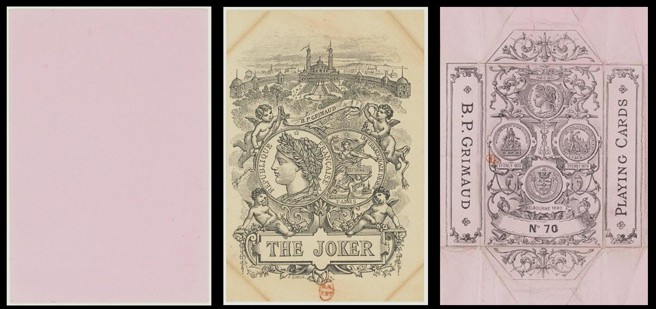
Apparently the decks had a different factory number with each back. No. 70 for the plain pink back and No. 100 for the blue design. Both decks had square corners. The No. 79 deck had rounded corners and a drawing of flowers on the backs.
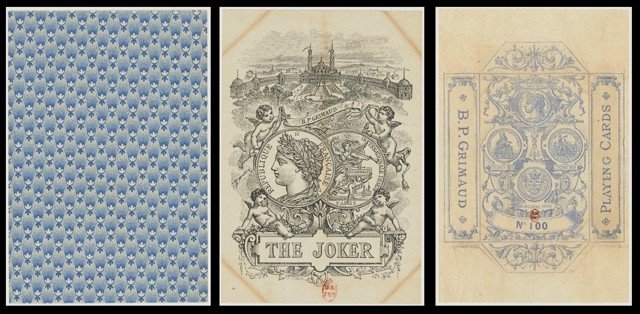
Even on the original images it's hardly visible, but the wrappers show a prize winning medal from the "Exposition Universelle" (World Exhibition) in Paris 1878, two from the International Exhibition (first World's Fair on the southern hemisphere) in Sydney in 1879 and one from the Melbourne International Exhibition of 1880. It confirms that the deck was published for the first time in Paris in 1878. What these wrappers also confirm is that evidently these cards were produced for export to English speaking countries: they mention "playing cards".
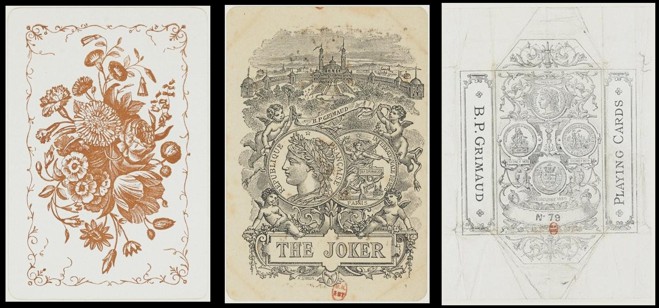
On 5/4/2017 we received a picture of the original woodblock for the wrapper from Pascal Pette.
